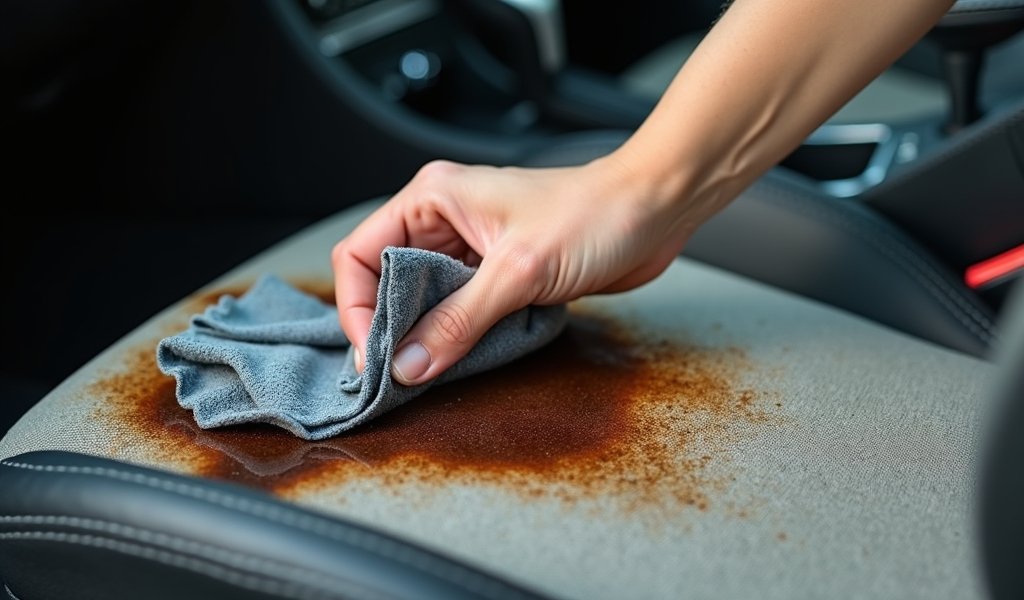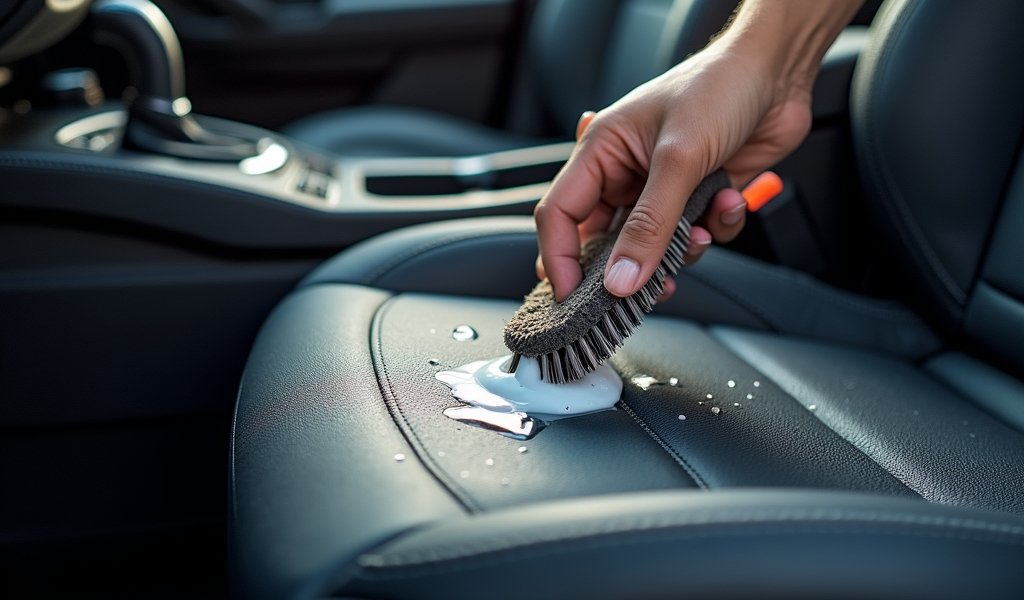Overview
This article provides practical guidance for removing various stains from car upholstery, with specific techniques for different materials (fabric, leather, vinyl) and stain types (coffee, grease, ink). It emphasizes acting quickly, using appropriate cleaning methods, and offers DIY solutions alongside prevention strategies, while acknowledging when professional cleaning services might be necessary.
Table of Contents
- Understanding Upholstery Materials
- Essential Cleaning Supplies
- General Stain Removal Process
- Tackling Specific Stains
- DIY Cleaning Solutions
- Professional Cleaning Considerations
- Preventing Future Stains
- Conclusion
- Frequently Asked Questions
Let’s face it – life happens in our cars. Whether it’s your morning coffee that didn’t quite make it to your mouth, kids with sticky fingers, or that takeout that took a detour to your seat, car upholstery stains are practically inevitable. As someone who’s spent 20 years getting hands-on with automotive interiors, I’ve seen (and cleaned) it all. The good news? With the right approach, even the most stubborn stains can be defeated.
Cars are essentially our second homes. The average American spends nearly 300 hours behind the wheel annually – that’s almost two weeks of your life! Don’t you deserve to spend that time in a clean, fresh environment? Beyond comfort, maintaining clean upholstery also preserves your vehicle’s value and extends the life of the interior materials.
In this comprehensive guide, I’ll walk you through proven techniques to tackle everything from coffee spills to mystery blotches that appeared from who-knows-where. Let’s restore your car’s interior to its former glory, one stain at a time.
Understanding Upholstery Materials
Before you start scrubbing away at that spaghetti sauce stain, take a moment to identify what type of upholstery you’re dealing with. Using the wrong cleaning method can turn a small spot into a bigger problem faster than you can say “oops.”
Fabric upholstery is the most common type found in vehicles. It’s relatively forgiving but can be quite absorbent. The good news is that fabric can handle a variety of cleaning methods, from steam cleaning to specialized fabric shampoos.
Leather upholstery requires special care. It’s naturally resistant to some stains but can be permanently damaged by harsh chemicals. Leather needs conditioning after cleaning to prevent cracking and maintain its supple feel. Remember, leather is skin – treat it accordingly!
Vinyl upholstery often masquerades as leather but is more resistant to water and staining. While it’s more durable than leather, petroleum-based cleaners can cause vinyl to deteriorate over time.
Alcantara and microsuede are delicate materials often found in luxury vehicles. These materials demand gentle treatment and specific cleaning approaches to maintain their distinctive texture.

Essential Cleaning Supplies
Having the right tools at your disposal makes all the difference between a frustrating experience and a satisfying cleaning session. Here’s what you should have in your car cleaning arsenal:
Basic Supplies:
- Microfiber cloths (several – these are the unsung heroes of car cleaning)
- Soft-bristled brushes (a toothbrush works great for detailed areas)
- Vacuum with upholstery attachments
- Spray bottles for DIY solutions
- Clean white towels for blotting
- Plastic scrapers or old credit cards for removing solids
Specialized Cleaners:
- Upholstery cleaner appropriate for your material
- Enzyme-based cleaners for biological stains
- Leather cleaner and conditioner (if applicable)
- Vinegar (nature’s cleaning miracle)
- Baking soda (great for odor absorption)
- Quality upholstery cleaner for tough spills
Remember, the gentlest effective option is always best. Start with the mildest cleaning solution before escalating to stronger products. Your upholstery will thank you for your patience.
General Stain Removal Process
When it comes to stain removal, timing is everything. Fresh stains are much easier to remove than those that have had time to set in. Here’s my tried-and-true process that works for most common stains:
1. Act Fast
Address spills immediately when possible. Blot (don’t rub!) excess liquid with paper towels or clean cloths. For solid messes, gently scrape away excess material with a plastic scraper or spoon.
2. Identify the Stain
Different stains require different approaches. Is it water-based (coffee, soda), oil-based (food grease, makeup), or protein-based (blood, vomit)? This knowledge will guide your cleaning strategy.
3. Test First
Always test any cleaning solution on an inconspicuous area first – under a seat or in a corner. This small precaution can save you from a much bigger headache later on. Wait a few minutes to ensure no discoloration or damage occurs.
4. Apply Appropriate Cleaner
Once you’ve tested your cleaner, apply it according to the type of upholstery. For fabric, apply sparingly and work from the outside of the stain inward. For leather, use minimal moisture and appropriate leather-specific products.
5. Gentle Agitation
Use a soft brush or cloth to gently work the cleaner into the stain. Avoid aggressive scrubbing, which can damage fibers or drive the stain deeper. Instead, think of it as coaxing the stain out with gentle persuasion.
6. Blot and Rinse
After the cleaner has had time to work, blot with a clean, damp cloth to “rinse” the area. Then blot with a dry cloth to remove excess moisture. Repeat if necessary.
7. Dry Thoroughly
Allow the area to dry completely. Use fans if needed, but avoid direct heat sources like hair dryers, which can set stains permanently. Proper drying techniques are crucial for preventing water spots and odors.
According to research from textile cleaning experts, the longer a stain remains, the more it chemically bonds with fabric fibers, making complete removal increasingly difficult. That’s why immediate action is your best ally in stain removal.
Tackling Specific Stains
Now let’s get down to the nitty-gritty of battling specific types of stains – the enemies we encounter most often in our automotive adventures.
Coffee and Soda Stains
These liquid culprits are common and can be stubborn due to their color and sugar content. Blot fresh spills immediately with paper towels. Mix a solution of mild dish soap with cool water and apply with a clean cloth, working from the outside in. For stubborn coffee stains, a paste of baking soda and water can work wonders on fabric upholstery.
Food Grease and Oil
The nemesis of clean car interiors! For fabric upholstery, sprinkle cornstarch or baking soda on the stain to absorb the oil. Let it sit for 15-20 minutes, then vacuum thoroughly. Follow with an appropriate cleaner for your upholstery type. For leather, use a commercial leather cleaner – avoid DIY solutions which might damage the finish.
Ink and Pen Marks
These can be particularly challenging but not impossible. For fabric, a small amount of rubbing alcohol on a clean cloth can work wonders (test first in an inconspicuous spot). For leather, commercial leather cleaner is your safest bet. Avoid using alcohol on leather as it can strip the color and damage the finish.
Blood and Protein-Based Stains
Always use cold water – hot water will set protein stains permanently! Blot with cold water, then apply a mixture of dish soap and cold water. Enzyme cleaners designed for pet stains are also effective for these biological messes. For leather, use minimal moisture followed by appropriate leather cleaner.
Mud and Dirt
Counterintuitively, allow mud to dry completely before removal. Then, vacuum thoroughly to remove loose particles before treating with fabric cleaner or leather cleaner as appropriate. Patience is key here – trying to clean wet mud often results in a bigger mess.
For those particularly stubborn or set-in stains, specialized car seat stain removers can be worth their weight in gold. They’re formulated specifically for automotive upholstery and often contain enzymes and surfactants that break down tough stains effectively.
Mystery Stains
We’ve all found them – those unidentifiable blotches of unknown origin. Start with mild cleaners and progress to stronger solutions as needed. Often, an all-purpose upholstery cleaner followed by specific treatment based on how the stain reacts will yield good results.

DIY Cleaning Solutions
Sometimes the best stain removers are already in your kitchen. These homemade solutions are effective, affordable, and typically gentler than commercial products.
All-Purpose Fabric Cleaner
- 1 cup warm water
- 1/4 cup white vinegar
- 1 tablespoon dish soap
- Optional: 1 tablespoon baking soda for extra deodorizing power
Mix in a spray bottle and use on fabric upholstery for general cleaning or fresh stains.
Leather Wipes
- 1 part white vinegar
- 2 parts linseed oil
Mix in a small container, apply with a soft cloth, and buff with a clean cloth. This cleans and conditions simultaneously. Note: Not suitable for suede or perforated leather.
Stain Lifter Paste
- Equal parts baking soda and water
Mix to form a paste, apply to fabric stains, let dry completely, then vacuum. Works well on set-in stains when other methods have failed.
Odor Eliminator
- Baking soda (straight from the box)
Sprinkle liberally on fabric upholstery, let sit overnight, and vacuum thoroughly. This absorbs odors rather than just masking them.
While DIY solutions are great for many situations, professional detailing associations recommend commercial products for valuable vehicles or particularly stubborn stains. Always test homemade cleaners in an inconspicuous area first.
Professional Cleaning Considerations
Sometimes, despite your best efforts, a stain refuses to budge. When should you wave the white flag and call in the professionals? Here are some guidelines:
When to Consider Professional Help
- When stains have set in for months or years
- When dealing with luxury materials like premium leather or Alcantara
- When home remedies have made the stain worse
- When preparing to sell your vehicle and want to maximize value
- When dealing with biohazard messes (severe pet accidents, body fluids, etc.)
What to Expect from Professional Services
Professional detailers have access to commercial-grade equipment like hot water extractors, steam cleaners, and specialized products not available to consumers. They can often revive upholstery that seems beyond salvation.
Expect to pay between $100-$300 for interior detailing, depending on your vehicle size and the extent of the cleaning needed. For luxury vehicles or severe staining, costs may be higher but are often worth it when you see the results.
When selecting a professional, look for certifications from organizations like the Institute of Inspection Cleaning and Restoration Certification (IICRC), which ensures technicians are properly trained in upholstery cleaning techniques.
Preventing Future Stains
An ounce of prevention is worth a pound of cure – especially when it comes to car upholstery. Here are some proactive measures to keep your interior looking its best:
Protective Products
Consider applying fabric protector spray on cloth upholstery or leather conditioner with UV protection for leather surfaces. These create a barrier that repels liquids and gives you precious extra seconds to clean up spills before they set in.
Strategic Defense
Keep an emergency car spill cleanup kit in your vehicle at all times. A simple kit with paper towels, wet wipes, a small spray bottle with cleaning solution, and a microfiber cloth can make the difference between a quick cleanup and a permanent stain.
Habit Changes
- Use travel mugs with secure lids instead of open containers
- Consider a “no food” policy (or at least no red sauces or chocolate!)
- Use seat covers when transporting pets or small children
- Apply sunshades when parked to prevent UV damage to upholstery
Regular Maintenance
Vacuum your car interior weekly to prevent dirt from grinding into upholstery fibers. Wipe down surfaces monthly with appropriate cleaners, and address any spills immediately – even if it’s just a preliminary blotting until you can do a proper cleaning later.
Conclusion
Your car’s interior tells a story – but it doesn’t have to chronicle every spill and accident along the way. With the right techniques, tools, and a bit of patience, even the most stubborn stains can be conquered, restoring your car’s interior to its former glory.
Remember that different materials and different stains require different approaches. Always start with the gentlest effective method and escalate as needed. When in doubt, test first in an inconspicuous area to avoid making matters worse.
The key to success lies in quick action, proper identification of both stain and upholstery material, and using the right cleaning agents. With the knowledge you’ve gained from this guide, you’re well-equipped to tackle most common car upholstery stains with confidence.
For those particularly stubborn stains that refuse to budge despite your best efforts, don’t hesitate to consult with professionals. After all, maintaining your car’s interior isn’t just about aesthetics – it’s about preserving your vehicle’s value and creating a pleasant environment for all those hours you spend behind the wheel.
Call Knows Your Car today for personalized advice on tackling those stubborn stains or to schedule a professional interior cleaning. Our team of automotive care experts is ready to help restore your car’s interior to showroom condition and provide solutions that keep it looking great for years to come.
Frequently Asked Questions
What’s the best way to remove coffee stains from car seats?
Blot fresh coffee stains immediately with paper towels, then clean with a mixture of mild dish soap and cool water. For set-in stains, try a paste of baking soda and water on fabric upholstery.
Can I use household cleaners on my car’s leather seats?
Most household cleaners are too harsh for leather upholstery and can cause damage. Stick with products specifically formulated for automotive leather to avoid drying, cracking, or color loss.
How do I remove ink stains from car upholstery?
For fabric upholstery, dab (don’t rub) the stain with a small amount of rubbing alcohol on a clean cloth. For leather, use only commercial leather cleaners as alcohol can damage the finish.
What’s the best way to clean vomit from car seats?
Remove solid matter, then clean with an enzyme-based cleaner designed for biological stains. Enzyme cleaners break down proteins in vomit and eliminate odors at the source rather than just masking them.
How often should I clean my car’s upholstery to prevent staining?
Vacuum weekly and treat any spills immediately as they occur. Perform a deeper clean with appropriate upholstery cleaner every 3-4 months, depending on use.

